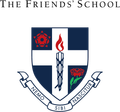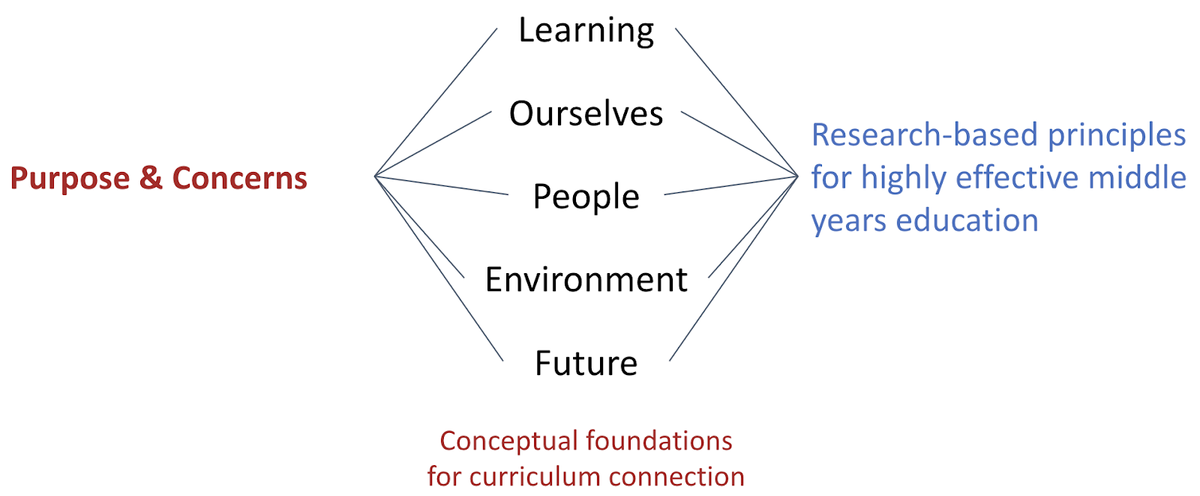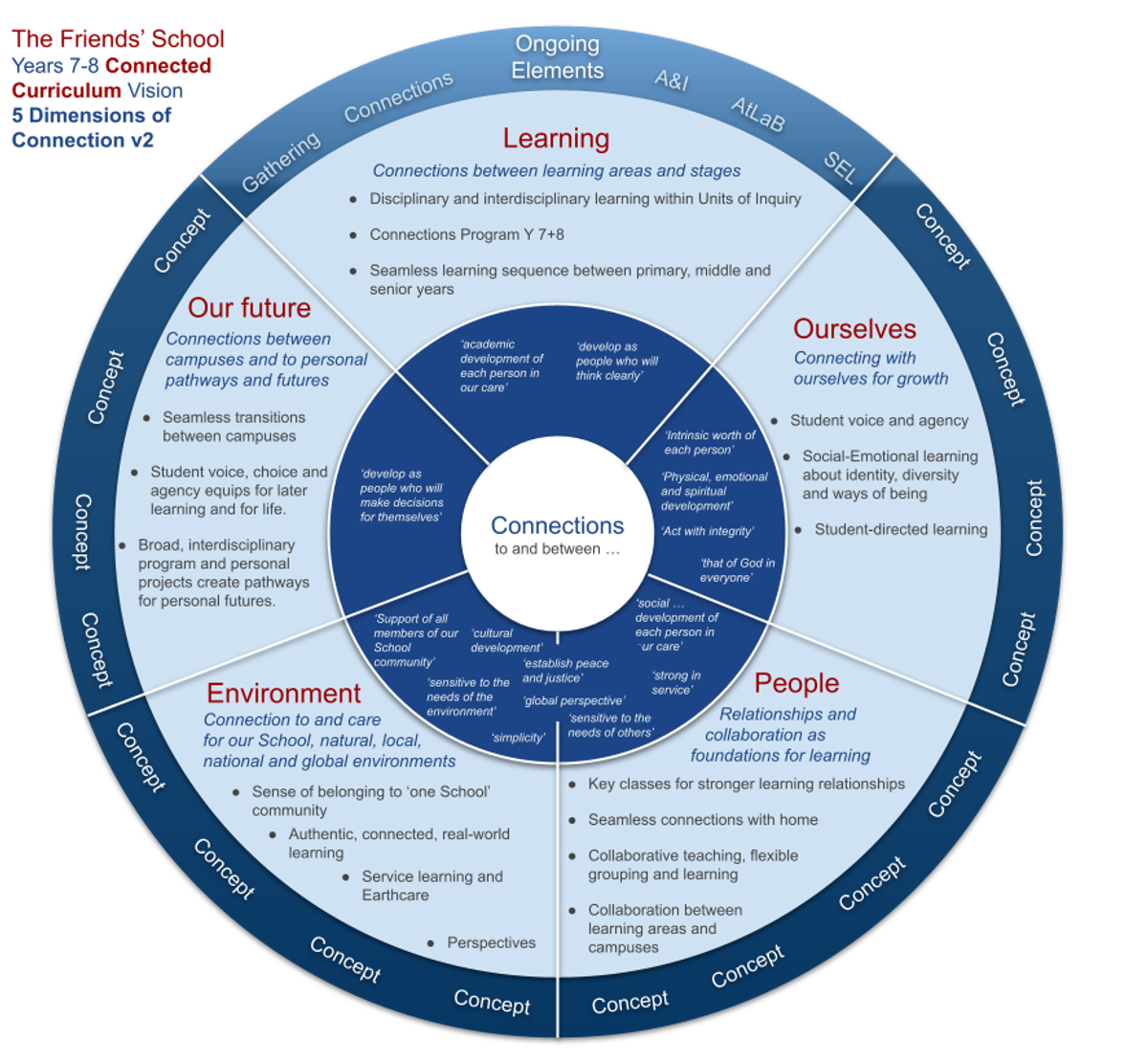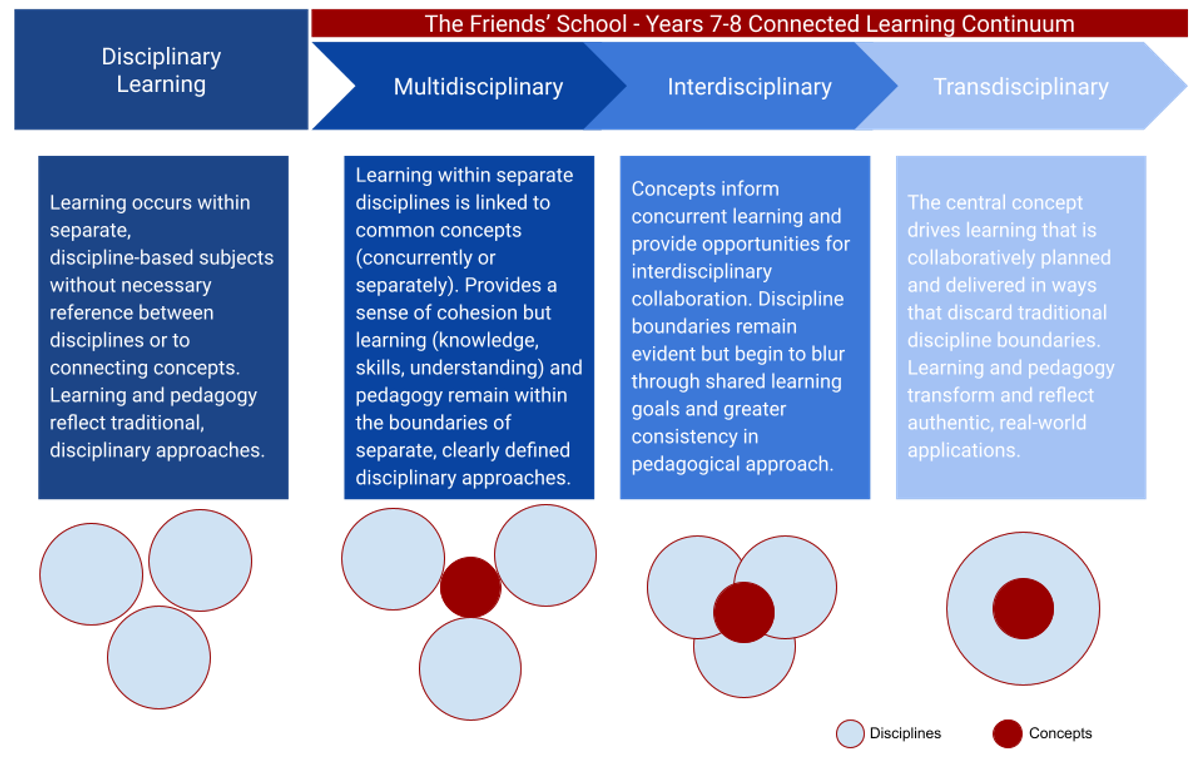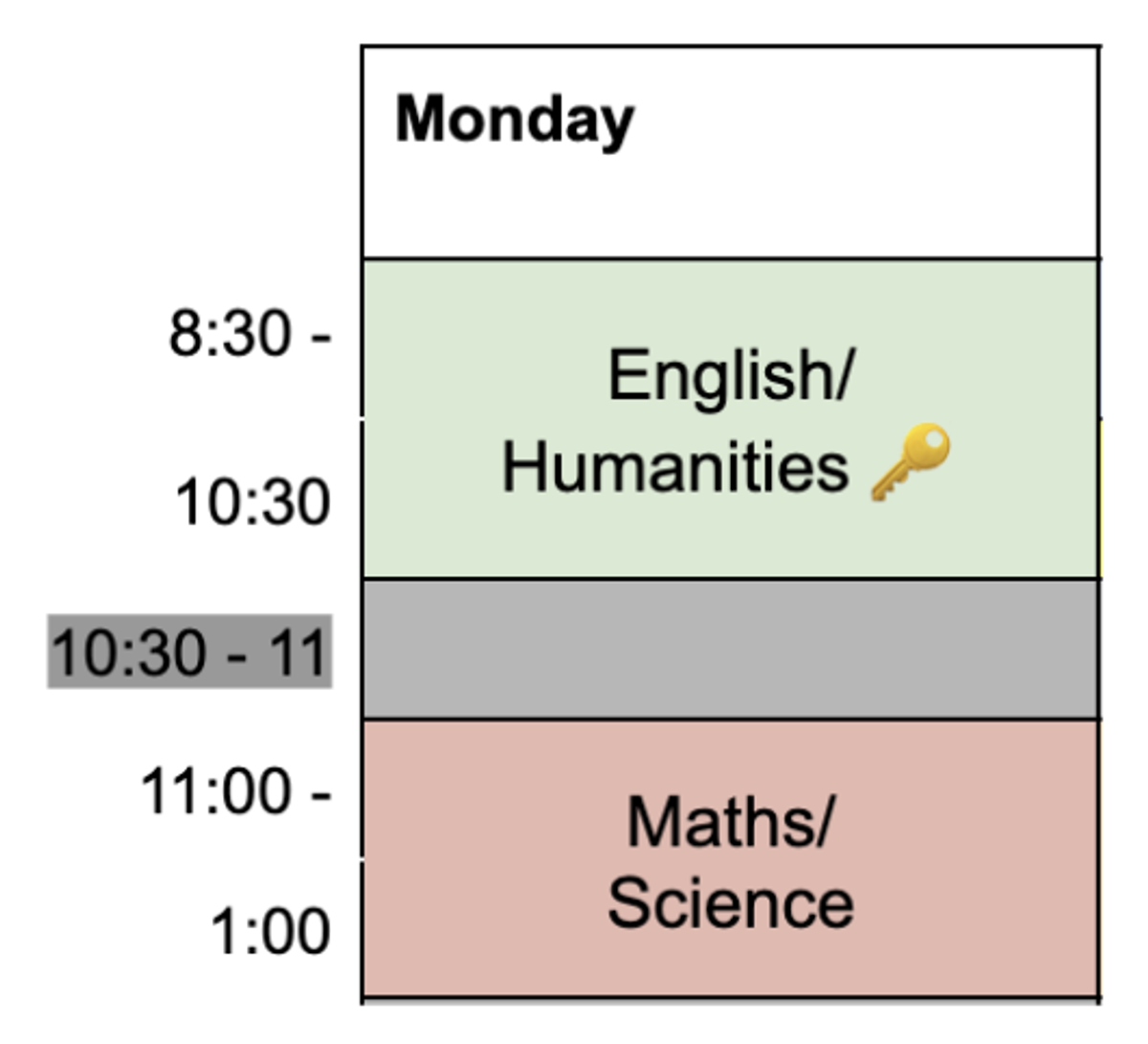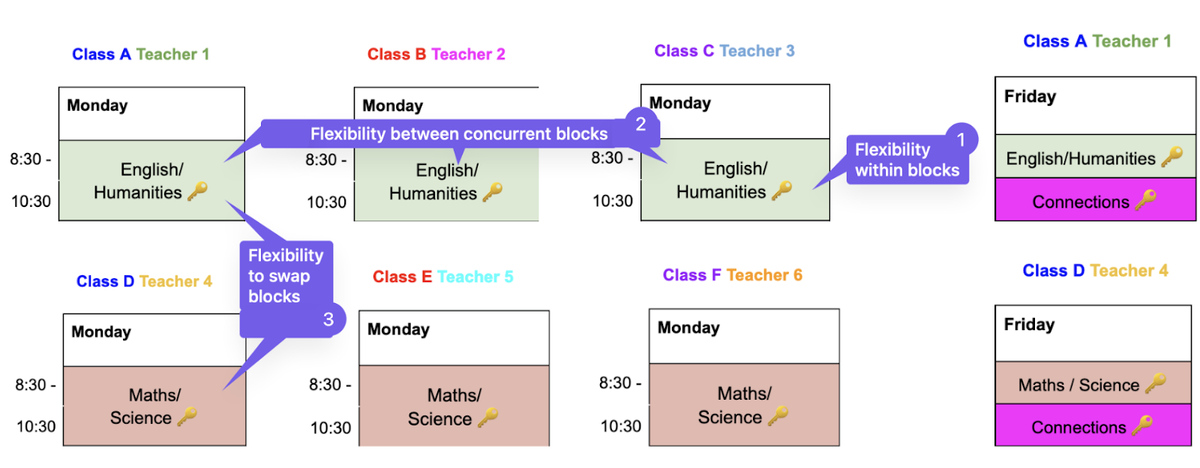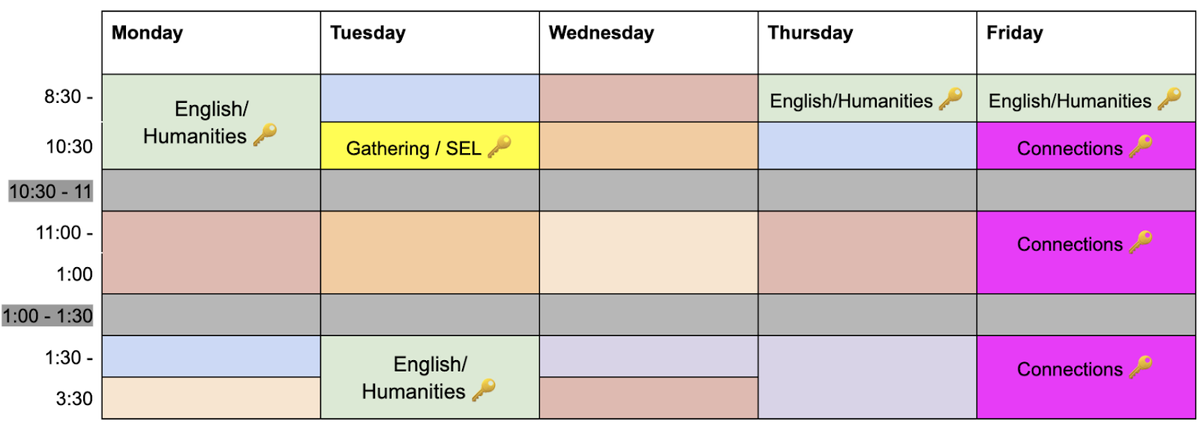Learning

Guiding Principles
Our Middle School Learning program is guided by and seeks to uphold The Friends’ School Purpose and Concerns, together with our E-12 Learning Principles, by providing the conditions in which ‘students learn best’ in middle years education. It is also guided by the following, overarching learning priorities for the Years 7-8 Campus:
- Embracing a whole-School (E-12) learning community perspective;
- Providing a seamless learning transition from Year 6 into 7, and from Year 8 into 9-12
- Improving learning outcomes for all students in Years 7 and 8.
Grounded in research-based principles for highly effective middle years education, we believe that the School’s Purpose and Concerns, Learning Principles and the Years 7-8 Campus Learning Priorities are best achieved through a learning design that that:
- Prioritises sustained relationships and a sense of belonging and community;
- Fosters learning experiences that are cross-disciplinary, active, creative and authentic;
- Engages students through dynamic pedagogy that is unique to the needs of young adolescents;
- Empowers students with agency, embraces diversity, and develops skills of learning and being;
- Is flexible in design and approach and responsive to diverse and changing needs.
Framework
Connecting Through Concepts
Our Purpose & Concerns give rise to five foundational concepts; concepts which also strongly align with the categories of best practice in middle years education. These, in turn, provide a framework of conceptual foundations to which we can connect the content and achievement standards of the Australian Curriculum:
Our Connected Curriculum Framework
Beginning with the statements of the Purpose & Concerns at the centre, the framework diagram below illustrates how our learning program is structured around the five domains of connection: connecting our Learning, connecting with Ourselves, with People, with our Environment and to our Future.
Key structural features and priorities of the Years 7-8 Campus and Curriculum are listed and aligned within each of these domains in the light blue ring.
In the dark blue outer ring, three or four concepts or inquiry questions will be agreed upon for each domain. By making one domain and its concepts a dominant focus of our learning program each term, this framework allows us to connect learning into a more cohesive whole across all learning areas.
Finally, the top of the diagram details the ongoing curriculum elements that form part of all of our learning programs.
Ultimately, this model gives us a shared language, both to leverage the many opportunities for connection that already exist in our curriculum, and to frame our development of increasingly interdisciplinary and transdisciplinary learning experiences in 2025 and beyond.
A ‘Connected Learning’ Continuum
We recognise that learning connection happens best on a flexible continuum, both in terms of the timing and the extent to which different disciplines connect. The following continuum model describes our approach to a connected curriculum in the Middle School.
Structure
The Years 7-8 curriculum is designed as a two-year program with the same core structure in each year.
A sample timetable
The Structure of the Day
Each day consists of three, two-hour blocks divided by half-hour breaks for both Recess and Lunch. Within the two-hour blocks, various combinations and lengths of subjects, learning and pastoral opportunities are possible.
Break times are intentionally aligned with those on the 9-12 Campus to facilitate sharing of physical and human resources and the possibility of staff and students crossing campuses.
Key Classes and Teachers 🔑
To ensure the best possible learning and pastoral outcomes, students in the Middle School belong to one Key Class and have sustained contact with the Key Teacher of that class, both as their teacher and primary pastoral carer.
Research into successful middle years education, and the success of our current Year 7 program, demonstrate the peer-relationship benefits of students belonging to one Key Class for each of their subjects. For example, students feel safer to take risks and have a voice and agency in their learning, and to explore their developing identity and ways of being, in a sustained, familiar learning community.
A Key Teacher with the cross-disciplinary and pedagogical expertise to teach this class in multiple learning areas also reduces the number, and strengthens, the teacher-student relationships that are critical to learning in the middle years.
Logistically, extending the Key Class concept across both Years 7 and 8 facilitates a simpler (and therefore more flexible) timetable structure.
The Key Teacher and Class model provides a year-long structure to support student learning and well-being within each year (class and teacher groupings change from Year 7 to Year 8).
Time spent with a Key Teacher is indicated by the 🔑 symbol in the sample timetable above.
Learning Areas and Subjects
Disciplinary and cross-disciplinary learning is grounded in 8 key learning areas, each of which form part of students’ program in both years as follows:
| Year 7 | Year 8 |
|---|---|
| English | English |
| Humanities | Humanities |
| Mathematics | Mathematics |
| Science | Science |
| Health/PE | Health/PE |
| Arts rotation: Art, Dance, Drama, Music | Arts rotation: Art, Dance, Drama, Music |
| Technology rotation: Foods, Fibre, Digital Tech, Design Tech) | Technology rotation: Foods, Fibre, Digital Tech, Design Tech) |
| Languages (French, German or Japanese) | Languages (continuation of chosen language) |
To ensure a middle years program that is rigorous, active and creative, students’ learning focus is balanced amongst all learning areas. 3 hours per week are timetabled for each learning area yet flexibility in the timetable design and delivery allow the program to be responsive and shift focus to suit learning, pastoral and year group needs in a given week or period.
Connections Program
| Year 7 | Year 8 |
|---|---|
| Connections | Connections |
Students also undertake a cross-disciplinary Connections Program in both years, providing deeper opportunities for authentic, interdisciplinary and transdisciplinary learning, curriculum flexibility and student agency. A day is timetabled each week for the Connections Program.
In the Year 8 Connections Program, the focus increasingly shifts towards students having the agency to connect their learning (across disciplines, to self, future, others, the wider world). This may take the form of student-led, personal projects, for example.
Cross-Disciplinary Learning Areas and Teachers
Where possible, teachers with the cross-disciplinary and pedagogical expertise will teach their class across multiple learning areas. This maximises relationship benefits through fewer, more sustained teacher-student connections, while also facilitating in-built opportunities for interdisciplinary learning.
Timetabling complementary learning areas together (eg - English/Humanities, Maths/Science) also creates more flexibility in delivery and opportunity for teacher collaboration (see below).
Learning Flexibility
The timetable and curriculum structure is intentionally designed to provide flexible opportunities in a number of ways.
For example, in the sample timetable, half of the cohort is scheduled to have an English/Humanities block, while the other half has Maths/Science. Classes are also paired (eg - A and D), with Teacher 1 also taking Class D for English/Humanities and Teacher 4 taking Class A for Maths/Science at a corresponding time. This pairing of Key Classes and Teachers then combine for the Connections Day.
As well as each cross-disciplinary teacher having the flexibility to shift and blur discipline focuses within their own teaching blocks (1), flexible groupings and collaborative teaching opportunities exist between concurrent blocks (2). Paired classes and teachers also allow the flexibility to swap blocks and learning focuses at a given time (3). See below.
In this scenario, the Key Teacher’s extended contact with their class also allows them to re-organise when learning in each subject area and Connections takes place within a given week. See below.
Opportunity Time
The extended learning time in the Connections program also provides the flexible time to support a range of opportunities, such as:
- Student-centred study time to support student agency and study skills development
- ‘Off-line’ learning components
- Student-led workshops, activities
- Teacher collaboration opportunities
- Co-curricular, service, enrichment.
Arts and Technology Rotations
Both the Arts and the Technology Learning Areas have 3 hours of timetabled classes per week. In each case, this time is divided between 4 focus subject areas noted above, each year.
Students rotate between the four subjects by completing one (approximately) 10 week course per term. This means that students study all four subject areas in each year, providing them with the opportunity to reconnect with the subject in Year 8 at a more advanced developmental stage and standard. The continuity of contact (one in each year) is also beneficial towards longer term study that students may elect to undertake in the Arts and Technologies.
Languages in Years 7 and 8
Students select one language (from French, German or Japanese) to study for the full year in both Years 7 and 8. Benefits of this model of language learning include:
- Supporting all students to learn and develop proficiency in a language for as many years of their schooling as possible;
- Reflecting a valued approach to sustained, deep language learning in a way that is consistent with our Purpose and Concerns;
- Supporting a whole-School perspective and providing for a more seamless transition into Year 7, through continuity of learning;
- Improving learning outcomes by supporting a higher level of study, therefore also supporting the transition into Years 9-12, particularly in preparation for IB Languages study.
Access and Inclusion
Support for learning, at all levels, is provided through an in-class, integrated (rather than separately timetabled) approach. This ensures that students still benefit from access to all learning areas and provides greater flexibility to support the full range of students.
Access and Inclusion staff are also ‘timetabled on’ as an integral part of the cross-disciplinary teaching and planning teams described above, and the concurrent timetabling of those programs allows dynamic groupings (including ‘pull-out’ groups) to support and extend students in specific combinations suited to each learning situation.
